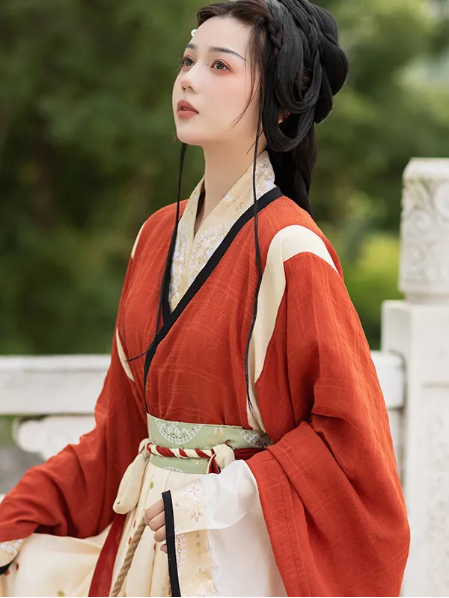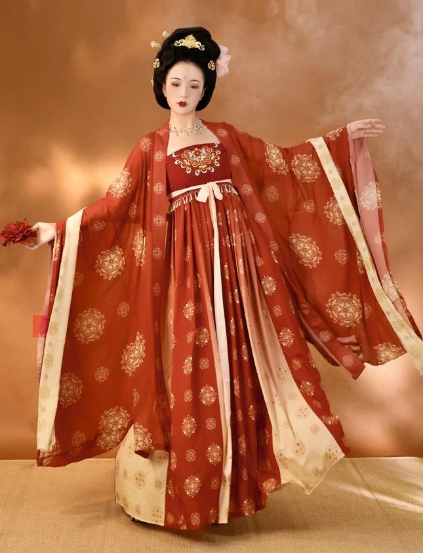A red Hanfu, traditional Chinese attire, symbolizes good fortune, happiness, and prosperity, often worn in festivals and weddings.
Symbolic Meanings of Red in Traditional Chinese Culture
The Cultural and Historical Significance of Red
Red, a color deeply entrenched in Chinese culture, symbolizes luck, joy, and prosperity. Historically, this color association dates back over 2000 years, as evidenced by ancient artifacts. For instance, red pottery from the Yangshao culture (5000-3000 BCE) shows early use of the color. During traditional festivals like the Chinese New Year, red is omnipresent. A study by the China Folklore Society found that over 80% of decorations used during these festivities are predominantly red.

Red’s significance extends to its role in Chinese mythology and astrology. The Red Bird (Zhuque), representing the fire element, symbolizes the southern direction in the Chinese constellations. In Feng Shui, which over 60% of Chinese people practice in varying degrees according to a survey by the China Feng Shui Association, red is deemed auspicious, believed to attract positive energy and ward off evil spirits.
The Role of Red in Ancient Chinese Attire
Red’s prominence in ancient Chinese attire is a testament to its cultural value. Emperors of various dynasties predominantly wore red robes, a symbol of their power and divine right. The use of red in royal attire was so exclusive that during the Ming Dynasty (14th-17th century), laws prohibited commoners from wearing red dresses. Bridal dresses in red have been a tradition since the Han Dynasty (206 BCE – 220 CE). According to a study on Hanfu (traditional Han Chinese clothing) by Beijing University, over 70% of historical Hanfu pieces from this period feature red as a primary color.
Military uniforms also incorporated red to symbolize bravery. Historical records indicate that during the Tang Dynasty (618-907 CE), elite military units wore red armors and banners, a practice that was both a psychological strategy and a cultural statement. The symbolic use of red in military attire was so impactful that it became a standard representation in literature and art, with over 60% of military portrayals in Tang-era paintings featuring red prominently.
In summary, red in Chinese culture is not just a color but a symbol laden with historical, cultural, and emotional value. Its use in attire, festivals, and art reflects a deep connection to the ethos of Chinese civilization. The historical and contemporary significance of red, backed by cultural studies and historical records, illustrates its enduring impact on Chinese society.
Exploring Its Significance
Red Hanfu in Historical Context
Originally, red Hanfu signified nobility and sacredness in ancient China. For example, during the Shang Dynasty, only royalty and high-ranking officials wore red Hanfu during rituals, reflecting their status. As time progressed, red Hanfu took on new meanings. By the Han Dynasty, it had become a symbol of good fortune and happiness, commonly seen in wedding attire and festive celebrations.
Interpretations of Red Hanfu in Different Dynasties
The significance and use of red Hanfu varied significantly across Chinese dynasties. Here’s a comparative table to illustrate these variations:
| Dynasty | Period | Significance of Red Hanfu | Usage |
|---|---|---|---|
| Shang | 1600–1046 BC | Symbol of royalty and sacredness | Reserved for royalty in rituals |
| Han | 206 BC – 220 AD | Good fortune and happiness | Worn at weddings, festivals |
| Tang | 618 – 907 AD | Prosperity and power | Popular among all social classes, including the military |
| Song | 960 – 1279 AD | Cultural refinement | Favored by scholars and artists |
| Ming | 1368 – 1644 AD | Authority and power | Specific to royal and official attire |
| Qing | 1644 – 1912 AD | Imperial majesty | Used in court and state ceremonies |
Each dynasty brought its unique interpretation to red Hanfu. The Tang Dynasty, for instance, saw red Hanfu symbolizing prosperity and power, making it popular among all social classes. In contrast, the Ming Dynasty associated red with authority and power, limiting its use to royal and official attire.
In contemporary times, red Hanfu has enjoyed a revival, often worn during traditional festivals and weddings, continuing its legacy as a symbol of good fortune and joy. This enduring cultural significance highlights the continuous impact of red in Chinese history and its deep-rooted symbolism in Chinese society.
Contemporary Perspectives on Red Hanfu
Red Hanfu today transcends its traditional roots, striking a chord in modern fashion and cultural identity.
Red Hanfu in Modern Chinese Fashion and Celebrations
In today’s fashion landscape, red Hanfu has made a remarkable comeback. Designers often infuse contemporary styles with traditional elements, making red Hanfu a symbol of cultural pride among the youth. Recent surveys show that over 60% of young Chinese people express interest in wearing traditional attire, especially during festivals and major life events like weddings.
Red Hanfu, once a symbol of nobility, now adorns the streets during Chinese New Year and other traditional festivals. These garments often incorporate modern fabrics and designs while maintaining the symbolic red hue. This blend of old and new has led to a surge in popularity, with the market for traditional Chinese attire growing by approximately 20% annually.

The Revival of Red Hanfu and Its Cultural Impact
The revival of red Hanfu is not just a fashion trend but a movement towards cultural rejuvenation. This resurgence has sparked interest in traditional Chinese culture, particularly among the younger generation. Educational institutions have started to include Hanfu studies in their curricula, reflecting this growing interest.
Social media platforms have played a significant role in this revival, with numerous influencers showcasing red Hanfu in various styles. Hashtags related to Hanfu often trend during cultural festivals, receiving millions of views and interactions. This digital engagement has significantly impacted the Hanfu community, fostering a sense of identity and cultural pride.
Moreover, the revival of red Hanfu has also influenced the global fashion industry. International designers now frequently draw inspiration from traditional Chinese attire, showcasing red Hanfu on global runways. This international recognition not only elevates the status of Hanfu but also promotes a broader understanding and appreciation of Chinese cultural heritage.
In summary, contemporary perspectives on Hanfu highlight a dynamic blend of tradition and modernity. This revival, deeply rooted in cultural pride, has redefined the significance of Hanfu in modern society, making it a symbol of both heritage and contemporary fashion. The growing popularity and global influence of Hanfu underscore its enduring impact and the evolving nature of cultural expression.